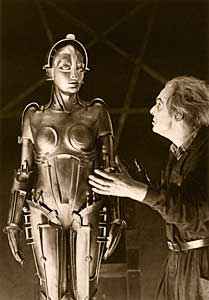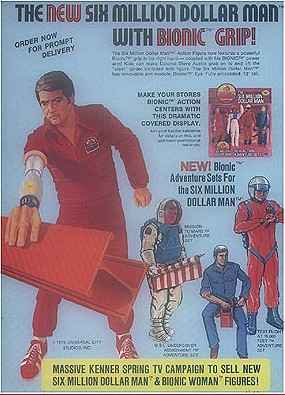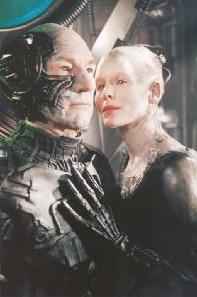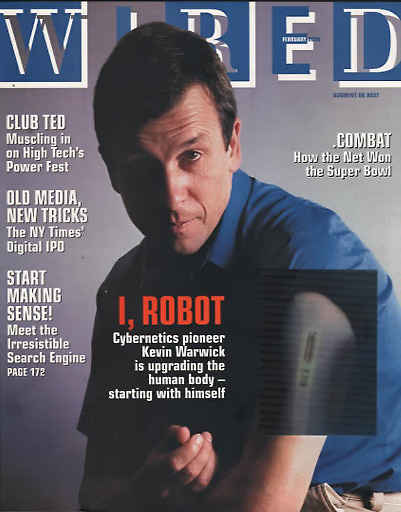|
Cyborgs The theory behind cyborgs goes like this: Fifty years of solid-state technology easily trumps 100 million years of evolutionary improvements.
The theory behind cyborgs goes like this: Fifty years of solid-state technology easily trumps 100 million years of evolutionary improvements. What could possibly go wrong? A cyborg is a human being who has been "enhanced" with technological additions to make him or her more than he or she was before, better, stronger, faster. A cyborg is not a robot, as any self-respecting Linux geek will explain to you at great length and in angry and indignant tones. Robots and androids are all artificial. The key to being a cyborg is that you're half man, half machine. The idea of the cyborg is historically notable for being one of the first intellectual concepts that can be traced to an origin in the movies. Although people had been strapping hooks and peglegs to stumps for several centuries, the notion of a truly functional substitute for a limb or other human part didn't gel until the 20th Century. In Fritz Lang's silent classic "Metropolis," a female robot is created directly from a human model. Later, the Frankenstein monster was a technologically reanimated being made from human parts. And he did have bolts attached to the side of his head (in the movie version, anyway), which were used for pumping him full of electricity, so he was technically a cyborg. The modern conception in which much more complicated things than bolts are added to the human anatomy had been kicking around since the Industrial Revolution, with variations on the theme appearing in the works of pulp sci-fi writers like Philip K Dick, but the word itself didn't enter the mass vocabulary until sometime in the 1960s, when the rise of transistors first made the idea feasible.
In 1973, one of the first popular depictions of a genuine cyborg was presented to the American public the "Six Million Dollar Man." The flaws of introducing such an important concept to the world in the format are practically too numerous to mention, but it sure was effective. Believe it or not, the "Six Million Dollar Man" was actually based on a book! With words and everything! "Cyborg," a novel by Martin Caidin, took a long hard look at the moral, spiritual and emotional ramifications of a man who has parts of his body replaced with mechanical substitutes after being dismembered a gruesome accident. In the hands of director/producer Richard Irving, whose other screen credits include "CHips" and "Pal, Fugitive Dog," the television show took a long hard look at orange jumpsuits, flying saucers and the Bionic Bigfoot.
After that, it was strictly a Gary Larson-style production with lots of jumping over big things, smashing hard things and lifting heavy things. The "Bionic Woman" which debuted to an even bigger success a few years later, was a bit more thoughtful about the whole fleshy bits issue, but still primarily concerned with superheroics. Steve Austin made being a cyborg look like fun, not least because his unfortunate accident conveniently spared his genitals (or so we were generally led to believe). For young kids aspiring to be neuroscientists, this would plant some unfortunate ideas which we shall revisit shortly. The idea of the Cyborg got fed through the Hollywood rehash machine, and as the 1970s thankfully came to a close, more sophisticated storytellers stepped up to the plate. OK, not a whole LOT more sophisticated, but still. Further imaginations of cyborgs looked at darker sides of the process, emphasizing the dehumanization that would seem to be an inevitable outcome of manufacturing plastic body parts. Movies like "Robocop" delved into the issue with ponderous attempt to mix high-concept paradigm-busting with low-concept bullet-ballet. By the time Star Trek introduced its version of the concept, called the Borg, cyborgs were being portrayed as all-out monsters. The Borg proved such a powerful image and provoked such extreme emotional responses that it quickly became the dominant metaphor for the dehumanizing potential of cybernetics, even though characters in science fiction fare like Trek and Star Wars routinely replaced amputated parts with mechanical equivalents without the slightest qualm.
The mechanics of creating humanlike parts were relatively simple. The real challenge was to find ways that a human nervous system could control those parts. The robot arm of the 1950s couldn't just be plugged onto a human stump and operated. The science of cybernetics was complicated by the immense complexity of the human nervous system. The map of nerves in the human body is incredibly complex and not-very well understood. The general idea was that a amputated nerve was like a clipped wire and you could just splice a real wire onto it, but making that work on a practical level is a hell of a lot more complicated, since a) nerves aren't really very much like wires, and b) there are about eleventy trillion nerves in the human body and it's not entirely clear what most of them do. One of the pioneers of modern cybernetics is a guy named Kevin Warwick, a member of the Steve Austin school of "ain't it cool" cyborgs. In the late 1990s, Warwick began putting his ideas into practice by experimenting on himself, the kind of thing that normally goes disastrously awry in comic books, but seems to be working out pretty well in real life. In 1998, Warwick implanted a simple computer chip in his body that simply identified him to technology in the vicinity, in the spirit of the worst dystopian conspiracy nightmares.
The array was also fitted with a radio transmitter, which was paired to a simpler device attached to his wife's arm, with the purpose of creating a really basic telepathic interface. Which pretty much worked. And yes, the motivation for this is exactly what you think it is. In a 2003 interview, Warwick said "Wouldnt it be good if you could have an implant and your girlfriend has an implant? And if she is getting excited, you get to know about it. Those things are going to be certainly excitement or if she is annoyed, you get to know about it and all sorts of other pieces of information. Sounds like a development certain to boost the worldwide sales of penis enlargement pills. In order to further his orgiastic aspirations, Warwick is currently working on his latest advancement of the same basic concept, this time a device which will allow him to send his brain impulses directly to the Internet. He plans to get this one off the ground in time for his 60th birthday, which is still more than a decade off. The implications for blogging alone are enough to call for an international ban on this experiment and all such future technologies. I mean, the Web is already clogged with inane, pointless, hourly ruminations plucked from a hundred thousand tedious lives. And THOSE people still have to type...
|
 Humans are a basically dissatisfied lot. The idea of adding enhanced parts to empower one's self carries a strong appeal, but at the same time, many people experience a basic and primal revulsion to the notion of replacing flesh and bone with switches and silicon.
Humans are a basically dissatisfied lot. The idea of adding enhanced parts to empower one's self carries a strong appeal, but at the same time, many people experience a basic and primal revulsion to the notion of replacing flesh and bone with switches and silicon.  OK, that's not entirely fair. The titular character, former astronaut Steve Austin (no relation to "Stone Cold"
OK, that's not entirely fair. The titular character, former astronaut Steve Austin (no relation to "Stone Cold"  Even as the depiction of cyborgs became increasingly sinister, cybernetics as science became more and more real. In the 1950s, scientists had first designed electrical equivalents of human arms for use in handling radioactive materials. By the '60s, simple computer-controlled robots were in production.
Even as the depiction of cyborgs became increasingly sinister, cybernetics as science became more and more real. In the 1950s, scientists had first designed electrical equivalents of human arms for use in handling radioactive materials. By the '60s, simple computer-controlled robots were in production.  In 2002, he upped the ante, with a surgically implanted array of electrodes in his arm. Attached to a nerve cluster near his elbow, the array is able to detect scores of specific nerve impulses. Using the array, Warwick was able to control simple electronic devices like electric wheelchairs and eventually a more complex artificial hand by simply willing them to move (in the same way you
In 2002, he upped the ante, with a surgically implanted array of electrodes in his arm. Attached to a nerve cluster near his elbow, the array is able to detect scores of specific nerve impulses. Using the array, Warwick was able to control simple electronic devices like electric wheelchairs and eventually a more complex artificial hand by simply willing them to move (in the same way you